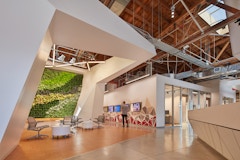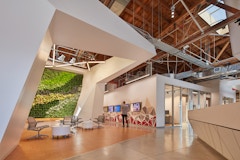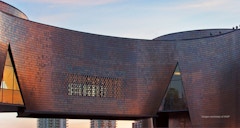
99 results
-
 With increasing interest in wellness and human-centric design in workplaces, the design of building enclosures is predicated on optimizing competing…
With increasing interest in wellness and human-centric design in workplaces, the design of building enclosures is predicated on optimizing competing… -

Daylighting Post-Occupancy Evaluation Study
- Paper by Jae Yong Suk, Ph.D., Helena Zambrano, AIA,
Daylighting is a key strategy to energy efficiency and improved occupant comfort, health, and productivity in buildings. However, providing desired… -

Event Passed
–High-Performance Building Facades
For architects, designers, engineers, manufacturers, consultants, and owners' representatives interested in methods for designing high-performance facades.
Industry Event by University of Massachusetts Amherst
-
Integrated Building Control System
- Paper by Jae Yong Suk, Ph.D., Associate Professor of Design, Associate Director of California Lighting Technology Center Keith Graeber, PE, Director of Engineering Andrew Harper, PE, R&D Engineer IV Michael Siminovitch, Ph.D., Director of California Lighting Technology Center
Integrated management of commercial lighting, heating, ventilation and air conditioning systems is considered as one of the most promising building… -

Two Sides to Sustainability & High-performance
- Paper by Brian Fraumeni · Julia Ragragio Ruiz, LEED AP BD+C · Adam Moqrane
High performance can be defined as “a building that integrates and optimizes all major high-performance building attributes, including energy
-

Geometric Patterns as Architectural Forms
- Paper by Joshua Schultz, PhD, PE, LEED AP, Assistant Professor Neil Katz, AIA, Associate
Facade design is a key component of architectural expression, and increasingly a key design consideration due to growing importance of factors like:… -

Active and Energy Autonomous Window
- Paper by Annalisa Andaloro · Leire Minguez Hilera · Stefano Avesani
Reducing GHG emissions related to energy use in buildings is a prominent obligation given their impact in terms of climate change. In this light,
-

Environmental Facade Perspective
- Paper by Patricia Shaw, M Arch., MSc Facade Engineering, Facade Specialist
Designing a sustainable rainscreen wall assembly has become an essential part of most new construction projects. Industry principles and energy codes… -

Event Passed
The ABCs of ZNE
The journey to a zero net energy (ZNE) future starts with renovating the current paradigm of building design. The way buildings are designed today needs a retrofit in thinking so new projects meet the challenges of the global climate crisis.
Industry Event by Verdical Group
-

Event Passed
The ABCs of ZNE
The journey to a zero net energy (ZNE) future starts with renovating the current paradigm of building design. The way buildings are designed today needs a retrofit in thinking so new projects meet the challenges of the global climate crisis.
Industry Event by Verdical Group
-

Event Passed
The ABCs of ZNE
The journey to a zero net energy (ZNE) future starts with renovating the current paradigm of building design. The way buildings are designed today needs a retrofit in thinking so new projects meet the challenges of the global climate crisis.
Industry Event by Verdical Group
-

Event Passed
The ABCs of ZNE
The journey to a zero net energy (ZNE) future starts with renovating the current paradigm of building design. The way buildings are designed today needs a retrofit in thinking so new projects meet the challenges of the global climate crisis.
Industry Event by Verdical Group
-

Event Passed
The ABCs of ZNE
The journey to a zero net energy (ZNE) future starts with renovating the current paradigm of building design. The way buildings are designed today needs a retrofit in thinking so new projects meet the challenges of the global climate crisis.
Industry Event by Verdical Group
-

The ABCs of ZNE
- Event by Verdical Group
The journey to a zero net energy (ZNE) future starts with renovating the current paradigm of building design. The way buildings are designed today needs a retrofit in thinking so new projects meet the challenges of the global climate crisis.
-
Introducing FacadeRetrofit.org
- Press Release
Los Angeles, CA – July 16, 2015 - While most of the green building dialog focuses on new construction, many have recognized that the fastest and most effective way to improve energy efficiency of the building sector is by remedying our existing building stock.
-

Event Passed
Facade Tectonics Forum: Simulation vs. Reality
The gap between simulated and actual energy performance has hobbled progress towards important carbon reduction goals in buildings and urban habitat. This summit advocates the need for improved energy modeling and the development of best practices, with emphasis on the building façade.
Forum by Facade Tectonics Institute, Inc.
-

Stop Relying on Myths – Energy Efficient and Durable Heritage Building Enclosures
- Article by David Kayll, FMA, P.Eng, President and senior building science specialist
-

Passive House Facade Design and Construction
- Paper by Louis Koehl, AIA, CPHD, Project Architect
Buildings account for over 40% of global emissions (GlobalABC, 2018). Growing populations and higher standards of living are increasing pressure on… -

Evaluating Additive Manufacturing for Metallic Facade Components
- Paper by Natasa Mrazovic, M. Arch. Eng., M.C.E., Martin Fischer,
The state-of-the-art of Additive Manufacturing (AM), popularly known as 3D printing, shows its prospective future in the… -

Optimized Adaptive Re-Use
- Paper by Matthew Parker, Intern Architect John Souleles, Principal
Contemporary building practice represents a disconnect between traditional manufacturing techniques, that favor straight runs and orthogonal…